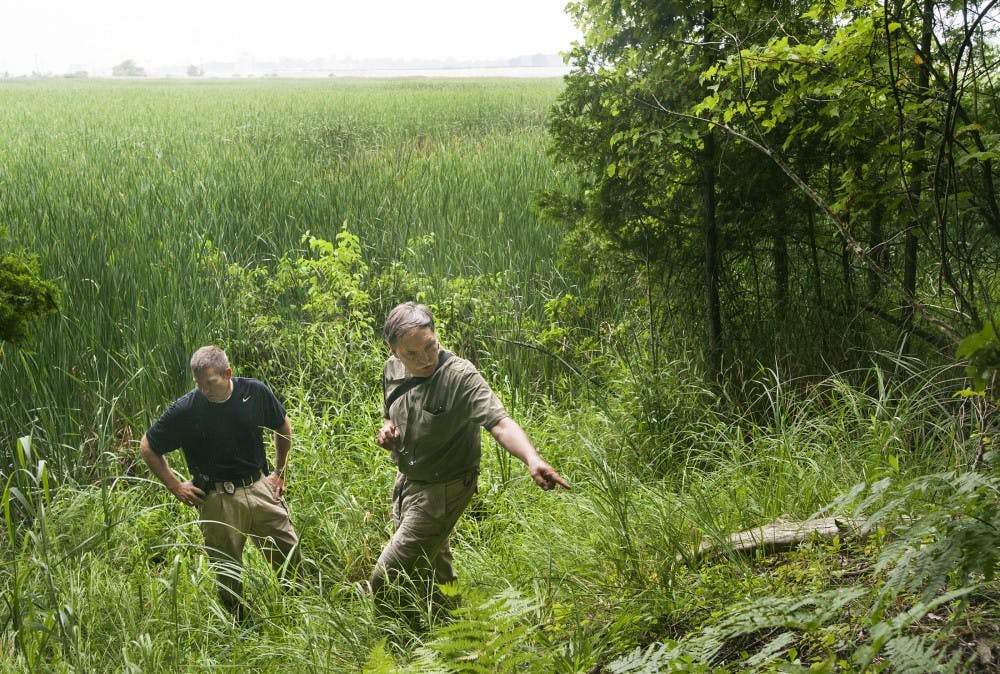Pouring rain, mosquitoes and thorns couldn’t sway Frank Telewski and Detective J.B. Wells away from climbing through the wooded areas of Ludington, Mich., in search for a “needle in a haystack.”
The needle — a species of plant, known as sedges — might connect the dots on the whereabouts and fate of a missing baby.
As Telewski and Wells made their way through the foliage, Telewski, a plant biology professor and curator of the W. J. Beal Botanical Garden, reminded Wells “sedges have edges, rushes are round,”
and the two joked of not “rushing” to any conclusion, a humor they have developed after nearly 10 months of work together on the Baby Kate case.
The laughter was ray of light in a dismal-looking situation as the two frequently became serious, contemplating whether the plants in the area matched the plant matter found on the suspect’s shoes.
The baby, or Katherine Phillips, has been missing for more than a year now, said Wells, a Ludington Police Department detective. She was four months old when she was last seen on June 29, 2011, with her father Sean Phillips before he returned home hours later with her clothes inside-out in his pocket, her car seat in the trunk and a different pair of shoes on than when he left.
Wells said Kate is now believed to be dead. Sean Phillips is currently serving a 10 to 15-year sentence for the unlawful imprisonment of his daughter.
“Our hope is to find where (Phillips) walked (and) where he acquired this plant material,” Wells said. “Our ultimate goal is to find Katherine, which would really cement the case against him … if we can’t find Katherine, we want to find where he walked to put her.”
Sean Phillips’ original shoes were discovered through a search warrant and brought to MSU for expert advice on the dirt still on them, Wells said. The search for expert advice led him to Frank Telewski.
Gardens to Gore
Telewski’s interest in plants started when he was just five or six-years-old, he said.
When his grandmother passed away when he was just a child, Telewski took it upon himself to continue her vegetable garden.
“I always enjoyed laboratory work and I always enjoyed being outdoors,” Telewski said. “I felt that if I could get a career … where I could have the opportunity to have a lab and do things in the laboratory, but also have the chance to be out in the field … that was going to be exciting to me.”
Telewski never imagined his interests would lead to forensics, but that’s where he found himself when he was working at the University of Arizona and was asked to identify the wood in a stick that was involved in the strangulation of a woman.
“I really remember when they brought the stick in. It smelled of death,” Telewski said. “You realize that gravity of (the case) but when you actually make that physical connection to the individual, it makes it harder.”
W. J. Beal Botanical Garden’s assistant curator and Telewski’s assistant Peter Carrington said the murder cases aren’t particularly more difficult than others because he focuses on the interesting, scientific aspect of it. He said he is no longer alarmed by deaths in the cases he works on because he previously worked with cadavers as a medical illustrator for MSU’s Division of Human Anatomy, and even found and brought home an 18th century human skeleton he found when he was eight-years-old.
“The hardest part is where you have a puzzle … and you cannot get a solution,” Carrington said. “I find it very interesting.”
An Expert Bunch
David Foran, director of MSU’s Forensic Science Program and associate professor, said MSU has anthropologists, entomologists, chemists, pathologists, biologists and other experts that are frequently contacted by police agencies.
Foran said forensic botany is one of the more rarely used forms of forensic science, but MSU’s forensic anthropologists often deal with more than 50 cases a year. He said more police departments should look into forensic evidence outside of basic DNA.
“It’s quite common that valuable evidence is overlooked.”
MSU professors that participate in these cases frequently do so at no cost to police agencies, besides fees related to the actual completion of the work, due to MSU’s land grant mission as a public university, Foran said.
Wells said this is the first time the Ludington Police Department has used a scientist with “this level of professionalism and knowledge in this area.”
Support student media!
Please consider donating to The State News and help fund the future of journalism.
“This won’t be the only thing that matters or the only thing that’s really going to win a case but in my opinion this is going to be a substantial piece of evidence,” Wells said. “When it come to … the value of Dr. Telewski and the things he’s done and the time he’s put in, it’s been just absolutely invaluable. (It’s been) absolutely priceless … and continues to be.”
Discussion
Share and discuss “The proof is in the plants” on social media.

